Rembrandt, Vermeer paintings in Louvre

The 17th century Dutch painter Rembrandt is represented in the Louvre. In the 1648 Emmaus pilgrims painting, Rembrandt focuses on Jesus' presence. A moment before, He looked like an ordinary man about to break bread with pilgrims. Now He is the resurrected Christ whose presence fills the room. Without distraction, Rembrandt convinces us we are witnessing the moment when the pilgrim's eyes open and they recognize him. Louvre Museum facts.
Rembrandt and Vermeer in Louvre
Complementary to the collections of Dutch paintings in the Rijksmuseum, Amsterdam, and Mauritshuis, The Hague, in the Netherlands, the collection of 17th century Dutch paintings of the Louvre Museum is of very high quality.
Rembrandt masterpieces in the Louvre include Bathsheba at her bath, Jan Six, philosopher in meditation, portrait of Maria Trip, Saint Matthew and the Angel, self-portrait, slaughtered ox and supper at Emmaus.
Vermeer masterpieces in the Louvre are the astronom and the lacemaker.
The collection is worth your time as part of a Louvre Museum visit. We recommend you a guided visit of the museum.
Paris museums | Famous French paintings in the Louvre
Louvre Flemish paintings | Italian renaissance paintings
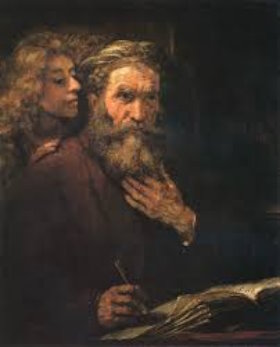
Saint Matthew and the Angel - Rembrandt
Location of Rembrandt and Vermeer paintings in Louvre Museum
Rembrandt and Vermeer paintings are on the second floor of the Richelieu wing.
Rembrandt Bathsheba at her bath, Saint Matthew and the Angel, slaughtered ox, supper at Emmaus paintings are in room 844. Vermeer lacemaker and the astronom paintings are in room 837.
Locate the Dutch painting department on Louvre Museum map PDF.
Bathsheba at her bath - Rembrandt - 1654
In the Bible old testament, Bathsheba was the wife of a general of King David's army. The King, upon seeing Bathsheba bathing, had her led into adultery. In this painting, Rembrandt focuses the scene on the bath of Bathsheba. She is deeply disturbed by the royal message.
Rembrandt painted Bathsheba from a live model. The opulence of this life size nude is exceptional in the Dutch painter's work: the nakedness of a beloved body, each fold of its triumphant flesh detailed, its eroticism highlighted by the transparent drapery and jewelry. This sensuality contrasts with the young woman's profound sadness.
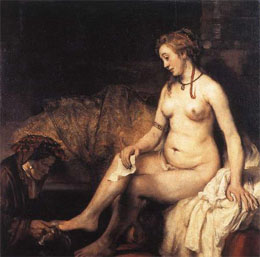
Bathsheba - Rembrandt - Louvre Museum
Self portait - Rembrandt - 1660
Rembrandt (1606 - 1669) is usually regarded as the greatest Dutch painter of his time. He worked first in his native Leiden and, from 1632 onward, in Amsterdam.
Rembrandt painted this self portrait at the easel at age 54, nine years before his death. The setting is the quiet enclosure of an interior. The artist's shadow shows little space between himself and the wall, suggesting there is only room enough for Rembrandt and his easel. A narrow field of light barely covers the scene, and shrinks the space within the frame to add intimacy. Rembrandt focuses our attention with a light source entering the frame. In this self-portrait, he intensified the prominence of the white cap above every other object in the frame. This modest symbol of Rembrandt's craft becomes itself a light source of almost spiritual dimensions. This suggests that it is through the act of painting that Rembrandt aspires to transcendence.
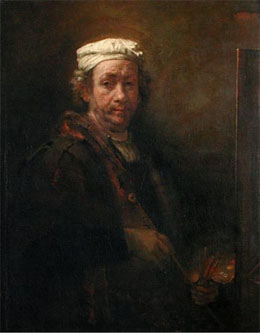
Self portrait at easel - Rembrandt - Louvre Museum
Stay in top Paris hotel with indoor pool

The astronom - Vermeer - 1668
Vermeer (1632 – 1675) was a Dutch painter who specialized in middle-class domestic scenes. Vermeer, a moderately successful painter in Delft during his lifetime, is now considered one of the greatest painters of all times.
Vermeer's Astronomer should not be interpreted as a portrayal of modern science. In Vermeer's time, all natural phenomena had a moral significance which implied God who had created nothing without a purpose.
The many Dutch 17th-century paintings representing astronomers reveal the interest in the study of the universe. The Astronomer was painted while Sun King was building an observatory in Paris (1667-72). In 1668, the young Isaac Newton improved the design of the reflecting telescope.

The astronom - Vermeer - Louvre Museum
The lacemaker - Vermeer - 1670
A young lacemaker bends over her work, holding the bobbins and pins needed for her work. Sitting close to the foreground, behind a lacemaking table, the lacemaker devotes her attention to this activity, while the viewer peers in with equal intensity. The woman is not wearing work clothes.
The marvelously colored cushion on the left is a sewing cushion, used to store sewing materials. The concentration of the model and the play of colors against the light gray background make this one of Vermeer's masterpieces. Renoir considered this masterpiece by the Dutch painter, which entered the Louvre in 1870, the most beautiful painting in the world, along with Watteau's Pilgrimage to the Island of Cythera, also in the Louvre.
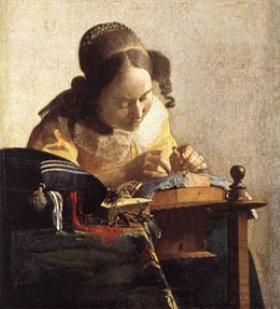
The lacemaker - Vermeer - Louvre Museum
See Dutch painter works in Louvre
The Louvre is open 9am to 6pm all days except Tuesdays, January 1, May 1, November 11, December 25. It is open until 9.45pm on Wednesdays and Fridays. Rooms begin closing 30 minutes before museum closing time.
Louvre Museum ticket price is 22 euros. Access is free for everyone on the first Friday of the month after 6pm, except July and August, and on July 14. Reservation is required. Buy Museum tickets.
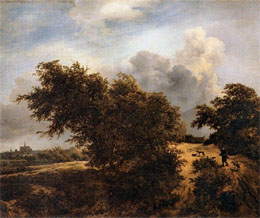
The bush - Ruisdael